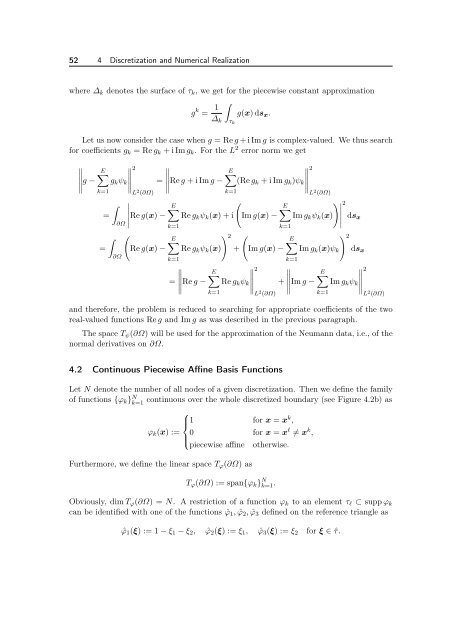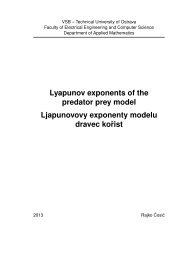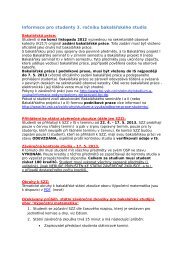The Boundary Element Method for the Helmholtz Equation ... - FEI VÅ B
The Boundary Element Method for the Helmholtz Equation ... - FEI VÅ B
The Boundary Element Method for the Helmholtz Equation ... - FEI VÅ B
You also want an ePaper? Increase the reach of your titles
YUMPU automatically turns print PDFs into web optimized ePapers that Google loves.
52 4 Discretization and Numerical Realizationwhere ∆ k denotes <strong>the</strong> surface of τ k , we get <strong>for</strong> <strong>the</strong> piecewise constant approximationg k = 1 ∆ kτ kg(x) ds x .Let us now consider <strong>the</strong> case when g = Re g + i Im g is complex-valued. We thus search<strong>for</strong> coefficients g k = Re g k + i Im g k . For <strong>the</strong> L 2 error norm we get E g − 2g k ψ kk=1==∂Ω∂ΩL 2 (∂Ω) E = Re g + i Im g − 2(Re g k + i Im g k )ψ kk=1E Re g(x) − Re g k ψ k (x) + i Im g(x) −Re g(x) −k=1L 2 (∂Ω)E2Im g k ψ k (x) ds xk=12 ERe g k ψ k (x)+ Im g(x) −k=1 E = Re g − 2Re g k ψ kk=1L 2 (∂Ω) 2EIm g k (x)ψ k ds xk=1 E + Im g − 2Im g k ψ kk=1L 2 (∂Ω)and <strong>the</strong>re<strong>for</strong>e, <strong>the</strong> problem is reduced to searching <strong>for</strong> appropriate coefficients of <strong>the</strong> tworeal-valued functions Re g and Im g as was described in <strong>the</strong> previous paragraph.<strong>The</strong> space T ψ (∂Ω) will be used <strong>for</strong> <strong>the</strong> approximation of <strong>the</strong> Neumann data, i.e., of <strong>the</strong>normal derivatives on ∂Ω.4.2 Continuous Piecewise Affine Basis FunctionsLet N denote <strong>the</strong> number of all nodes of a given discretization. <strong>The</strong>n we define <strong>the</strong> familyof functions {ϕ k } N k=1continuous over <strong>the</strong> whole discretized boundary (see Figure 4.2b) as⎧⎪⎨ 1 <strong>for</strong> x = x k ,ϕ k (x) := 0 <strong>for</strong> x = x⎪⎩l ≠ x k ,piecewise affine o<strong>the</strong>rwise.Fur<strong>the</strong>rmore, we define <strong>the</strong> linear space T ϕ (∂Ω) asT ϕ (∂Ω) := span{ϕ k } N k=1 .Obviously, dim T ϕ (∂Ω) = N. A restriction of a function ϕ k to an element τ l ⊂ supp ϕ kcan be identified with one of <strong>the</strong> functions ˆϕ 1 , ˆϕ 2 , ˆϕ 3 defined on <strong>the</strong> reference triangle asˆϕ 1 (ξ) := 1 − ξ 1 − ξ 2 , ˆϕ 2 (ξ) := ξ 1 , ˆϕ 3 (ξ) := ξ 2 <strong>for</strong> ξ ∈ ˆτ.









